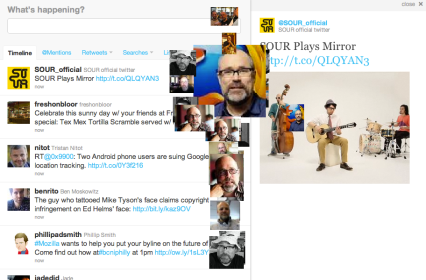Recently, we’ve seen a huge change in video online. The advent of web native video makes it possible to mash up moving images with social media, tie clips to data from across the web or, more simply, create simple transcript-based interfaces for navigating
long pieces of video. Yet, despite these capabilities, we’ve seen
almost nothing in the way of new kinds of storytelling. Telling stories
with video online today looks pretty much the same as it did when I used
to shoot local TV news 20 years ago.

This is something we hope to change with the first Knight Mozilla news innovation challenge topic. We’re inviting hacks and hackers from around the world to answer the question: How can new web video tools transform news storytelling? People with the best ideas will get to bring them to life with a full-year paid fellowship in a world-leading newsroom.
The Next ‘Montage Moment’
What do I mean by transform storytelling? Just that: taking
today’s online video tools beyond the mechanical and obvious, bringing
people, ideas and events to life in ways we haven’t seen before. To get your imagination going, think back to how visual storytelling emerged in the world of cinema.
The Lumiere brothers made some of the world’s first films: “Workers Leaving the Lumiere Factory,“ “Arrival of a Train at the Station,” etc.
The Lumieres’ fixed frame wasn’t much to write home about in terms of
story. But seeing moving photographs was hugely impressive to most
people at the time. It was a technical wonder.

It took 25 years for Sergei Eisenstein
to grab hold of this technical wonder and then say: Wow, I bet we could tell a more powerful
story if we varied the shots a bit and then edited them together. With “The Battleship Potemkin,” he invented the visual language we still use to tell stories today: montage.

The
fundamental technology didn’t change in those 25 years. The Lumieres
knew how to splice film and move the camera around. Eisenstein’s
breakthrough was to use basic film technology to tell a story in a new
and creative way — which is very much like where we are at with web native video today: huge technological potential just waiting to be seized for creative storytelling. What we need now is a “montage moment” for the web era.
Open Video: A Huge Palette of Awesomeness
The potential of web native video truly is awesome: We can now link any frame within any video to any other part of the web. This was hard to do in the world of Flash video. The introduction of the HTML5 <video> tag over the last two years has made it easy.
Early experiments and demos hint at the potential of this new open video palette. With the recent State of the Union address, PBS used Mozilla’s popcorn.js tools to synchronize its live blogging with the timecode of the president’s speech:

The same tools have been used to show how transcripts can be used to search and then navigate immediately to anywhere within a long clip. This demo from Danish public radio shows how this can work with web native audio. The same thing could easily be done with video.

Of course, the big potential is in connecting video to the massive amount of media and data that already exist all across the web.
Imagine if you could weave the sum of all human knowledge seamlessly
into your news story or documentary. That’s now possible. This book report demo shows the basics concept, with a student connecting her narration to Wikipedia articles and news reports.

Google and Arcade Fire took this idea a step further, pulling moving images from street view and Google Earth into a rock video. If you enter your ZIP code, your neighborhood becomes a character in the narrative in real time.

The Japanese-based Sour “Mirror” went even further, pulling you into the video. Enter your Facebook ID and turn on your camera, and then you become a character in the band’s video — again, in real time.

These demos make an important point: The line between what’s in the frame and what’s on the web is dissolving. Or, put nerdily, timecode and hypertext are fusing together. They are becoming one.
Are You the Next Eisenstein?
Despite all the niftyness, there is a problem: These demos do not yet tap the open video palette to tell stories in meaningfully new ways. Open video tools like Mozilla’s Popcorn and Butter
provide a starting point. But they need people with a creative flare
for both web technology and storytelling to bring them to life. Which is exactly why Knight and Mozilla threw out “how can new web video tools transform news storytelling?” as our first MoJo challenge question.
We’re hoping that you — or someone you know — is up to this challenge. If you think you are, you should enter the MoJo innovation challenge. All you need to do is draw up a napkin sketch showing how you might tell a story in a new way with open video, write a brief paragraph about it, and then submit it online.
If your idea is solid, you’ve got a good chance at a fellowship where
you could actually bring it to life at the Al Jazeera, BBC, the
Guardian, Die Zeit or the Boston Globe. Who knows? Maybe you could be
the Eisenstein of open video.
Find out more about Knight Mozilla News Innovation Partnership on the MoJo website. Or enter the MoJo news innovation challenge today.
